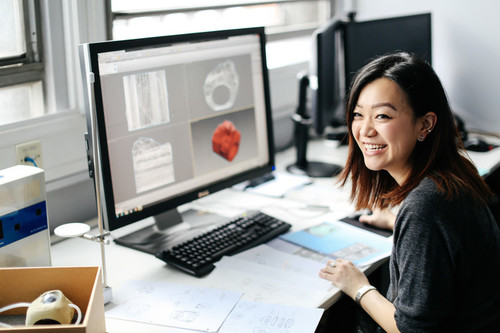Coronavirus
Tips on setting up your workstation at home
Working at home is a brand new experience for many of us, whether we're trying to type, sculpt, paint, sew or draw.
During this time, it's really important that you look after your posture and eyesight. To help you achieve this, we have put together a list of simple instructions below.

Desk, table or work area
Choose a work area where you can sit at a desk or table. Clear or tidy your working area so you can set up your desktop PC or laptop and have space to work.
Position your IT equipment in front of you, not to the side or at an angle, as this reduces the risk of neck/back pain and injury.
If you have a separate computer screen, adjust it so that the top of the screen is at eye level and at an arm’s distance from you. This will minimise strain on your eyes and neck.
Ideally, when sitting at your desk or table, your arms should be relaxed and to your side with your forearms parallel to the desk or table you are using. Adjust your chair to help you achieve this.
If you are using a laptop and have a separate keyboard and mouse, make use of these. If not, take regular breaks from typing, or try to schedule more phone calls to reduce the need to type.
Consider using voice activated software if you find it hard to type.
Check that your wrists and hands are relaxed, you should try to maintain a straight line from your elbow to your wrists (i.e. avoid positioning your wrists at an awkward angle).
Try to work on a desk or a stable surface.

Seating
You can even try standing rather than sitting – be creative, you can try using an ironing board to replicate a standing desk.
Make sure your feet are supported and keep your hips higher than your knees. You can use a box as a footrest to achieve this.
Choose a chair that supports your lower back and allows you to sit comfortably with your feet flat on the floor or on a footrest. You may want to use a cushion to raise the seat, or a rolled up towel to support your lower back.
Working on a sofa or armchair is not ideal although we are all guilty of it. Lower your risk of pain and injury by working here for no longer than 15 to 20 minutes and only do tasks that require minimal interaction with your laptop such as reading reports or browsing the internet.

Lighting and ventilation
Try to work with natural daylight as much as possible.
Open your windows to improve air circulation and ventilation, this will help you get some fresh air whilst working if you can’t go outside.
If you find that there is a glare on the screen from windows or lights, you can try to reposition your screen or close your blinds. You can also use a desk lamp to improve lighting.
Ergonomics
- Poor sitting positions and badly laid out desks or tables can result in neck and back pain, wrist and arm injuries, eye strain and headaches. You should take regular breaks every 20 minutes. Advice on good posture when sitting at a desk and how to organise your work area to reduce the risks of injury can be found in these two helpful videos:
If you are staying in halls during lockdown and would like further information about how to create a safe workstation, please contact your Halls' team, who will be more than happy to help you.
- Read Next
-
 UAL Accommodation Open Day 2024
UAL Accommodation Open Day 2024
 No.1 empty your fridge recipe
No.1 empty your fridge recipe
 Sip into summer: New seasonal drinks on offer
Sip into summer: New seasonal drinks on offer
 Calling all Trans and Non binary students...
Calling all Trans and Non binary students...
 Gelato and waffles at London College of Communication
Gelato and waffles at London College of Communication
 Eat for less with these unmissable offers
Eat for less with these unmissable offers
 Value in every meal
Value in every meal
 Easter egg rocky road
Easter egg rocky road
 Leftover chocolate egg brownies
Leftover chocolate egg brownies
 Hike and Cyanotype Photography - Hampstead Heath!
Hike and Cyanotype Photography - Hampstead Heath!
- Popular
-
 How to get a National Insurance Number in the UK
How to get a National Insurance Number in the UK
 The ultimate guide to your new home
The ultimate guide to your new home
 YOUR WELCOME WEEKEND VIDEO - 2018
YOUR WELCOME WEEKEND VIDEO - 2018
 How to apply for discounted student travel
How to apply for discounted student travel
 Get in contact with your hall
Get in contact with your hall
 8 things different about life in the UK vs China
8 things different about life in the UK vs China
 Opening a student bank account in the UK
Opening a student bank account in the UK
 Make sure to register at your GP
Make sure to register at your GP
 Fire Safety in Halls
Fire Safety in Halls
 Student tours of UAL halls
Student tours of UAL halls



